
Fly fishing is a captivating sport that combines skill, patience, and a deep appreciation for nature. For beginners, the world of fly fishing can seem daunting, with various techniques, equipment, and terminology to learn. However, understanding the fundamentals and having the right gear can make the experience enjoyable and rewarding. This comprehensive guide will explore the essential gear needed for beginners in fly fishing, broken down into five subtopics: fly rods, fly reels, fly lines, fly patterns and flies, and additional accessories.
Fly Rods: The Foundation of Your Setup
Choosing the right fly rod is crucial for beginners, as it serves as the foundation of your entire setup. The fly rod’s action, length, weight, and material all play a significant role in your fishing experience, influencing your casting technique and the types of fish you can target.
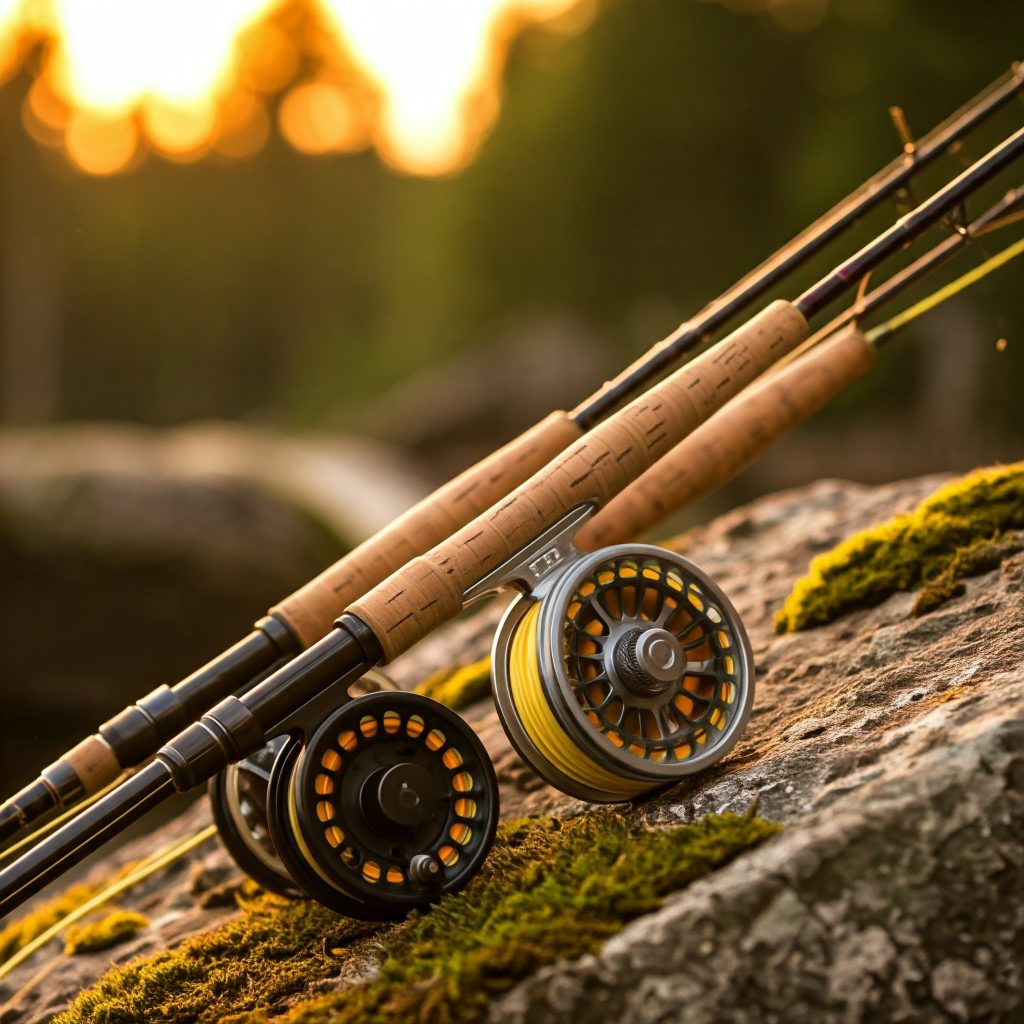
Action and Flex
Fly rods come in different actions, which refer to how much the rod bends when pressure is applied. Understanding rod action is essential for beginners, as it affects casting distance, accuracy, and sensitivity.
- Fast Action: Fast action rods bend primarily at the tip, providing quick response and excellent casting distance. These rods are ideal for experienced anglers who want to cast larger flies over longer distances, making them suitable for saltwater fishing or targeting larger species.
- Medium Action: Medium action rods offer a balance between sensitivity and power. They bend in the upper third of the rod, making them versatile for various fishing techniques. Beginners often find medium action rods easier to cast and more forgiving, making them an excellent choice for starting out.
- Slow Action: Slow action rods bend more throughout their length, offering a softer feel and greater sensitivity. These rods are suitable for delicate presentations, such as when targeting smaller fish or fishing in calm waters. They are often favored for small stream fishing and delicate dry fly presentations.
Length and Weight
The length of your fly rod will affect casting distance, line control, and the type of water you’ll be fishing. Fly rods typically range from 7 to 10 feet in length.
- Shorter Rods (7-8 feet): Ideal for tight spaces and small streams, shorter rods offer better maneuverability and control. They are excellent for fishing in overgrown areas where longer rods may be cumbersome.
- Medium-Length Rods (8-9 feet): These rods are versatile and suitable for various fishing scenarios. They provide a good balance of casting distance and control, making them ideal for both rivers and lakes.
- Longer Rods (9-10 feet): Longer rods are better for casting longer distances and controlling line on larger bodies of water. They are particularly useful in situations where you need to mend your line or reach fish that are further away.
In terms of weight, fly rods are rated according to the weight of the line they are designed to cast. For beginners, a 5 or 6-weight rod is an excellent starting point, as it is versatile enough for various freshwater species such as trout and panfish.
Material and Construction
Fly rods are typically constructed from graphite, fiberglass, or bamboo. Each material has its pros and cons:
- Graphite: The most popular choice for modern fly rods, graphite rods are lightweight, sensitive, and durable. They offer excellent casting performance and are suitable for various fishing scenarios.
- Fiberglass: While less common, fiberglass rods are known for their durability and smooth casting. They offer a slower action, making them ideal for beginners learning to cast. Fiberglass rods are often favored for small stream fishing.
- Bamboo: Bamboo rods are traditional and known for their beauty and craftsmanship. They offer a unique casting experience but can be expensive and require more maintenance. For beginners, bamboo may not be the most practical choice.
Fly Reels: Balancing Function and Style
While the fly rod is the primary tool for casting, the fly reel plays a crucial role in line management and fish fighting. For beginners, selecting the right reel is essential for a successful fly fishing experience.
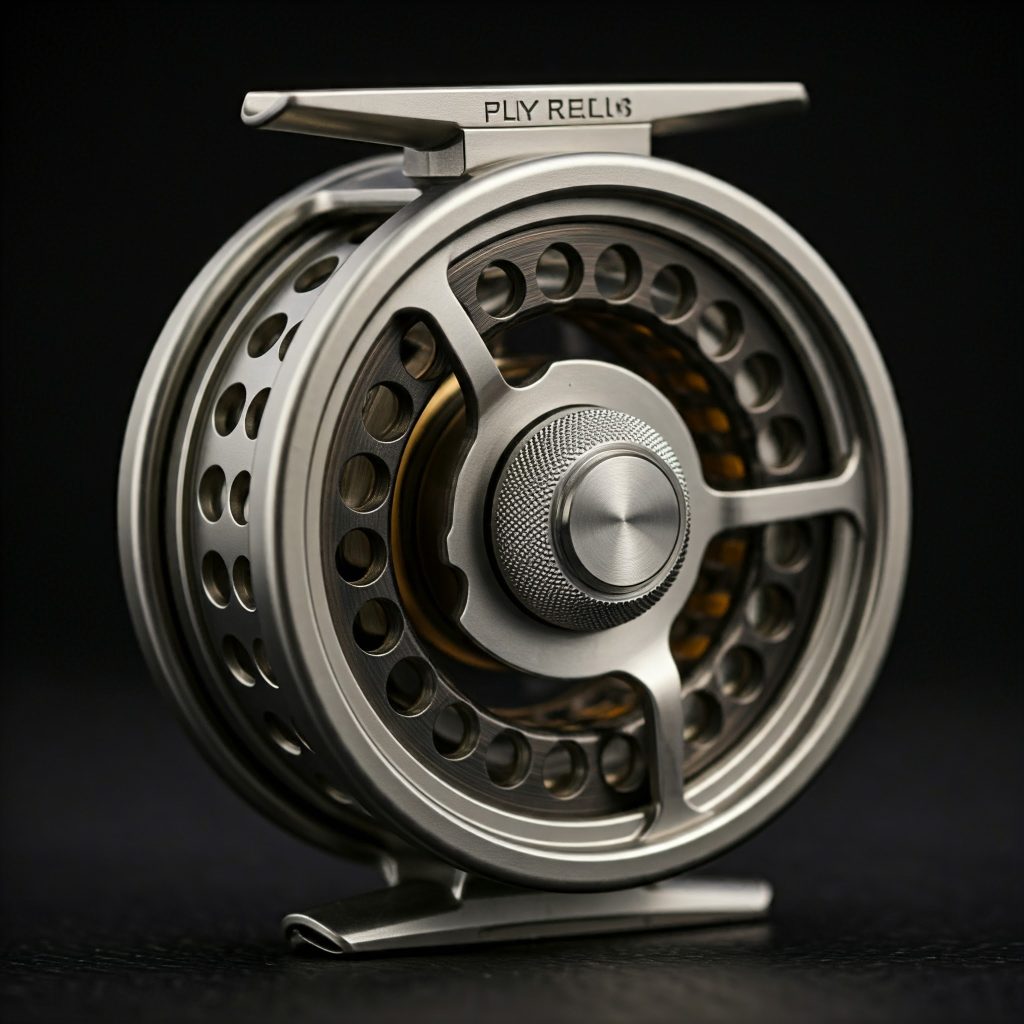
Types of Fly Reels
There are several types of fly reels available, each designed for specific fishing techniques and conditions. Understanding these types will help beginners choose the right one for their needs.
- Single Action Reels: Single action reels are the most basic type, featuring a simple mechanism that allows the angler to retrieve line with a single turn of the handle. These reels are easy to use and ideal for beginners learning the fundamentals of fly fishing.
- Multipliers or Gear Ratio Reels: These reels allow the angler to retrieve line more quickly by using gears to increase the ratio of handle turns to line retrieval. They are suitable for fishing in fast-moving waters or when targeting larger species.
- Pawl Reels: Pawl reels are traditional fly reels that use a pawl and ratchet system to engage the drag. These reels are simple and effective, making them a good choice for beginners. They offer a classic feel and are often favored for their durability.
- Disc Drag Reels: Disc drag reels feature a smoother drag system that allows for more controlled line retrieval. They are particularly useful for fighting larger fish and provide better control during the fight. For beginners, a disc drag reel may be a good investment for its ease of use and reliability.
Size and Weight
When selecting a fly reel, it’s essential to match its size to your rod and line weight. Fly reels are typically rated for specific line weights, ranging from 3 to 12 weight or more. For a beginner’s setup, a reel rated for 5 or 6 weight lines will pair well with a corresponding rod.
- Small Reels (3-5 weight): These reels are lightweight and suitable for targeting smaller freshwater species, such as trout and panfish.
- Medium Reels (5-7 weight): Medium reels are versatile and can handle a range of species, making them ideal for beginners who want to explore different fishing scenarios.
- Large Reels (8 weight and above): Larger reels are designed for saltwater fishing or targeting big freshwater species like pike or bass. Beginners may want to focus on smaller reels until they gain more experience.
Drag System
The drag system is crucial for controlling the line during the fight with a fish. A smooth drag allows the fish to run without breaking the line. Beginners should look for reels with adjustable drag systems that are easy to use and provide consistent resistance.
- Adjustable Drag: Many modern reels feature adjustable drag systems that allow anglers to fine-tune the resistance based on the size of the fish being targeted. This feature is essential for preventing line breakage during a fight.
- Sealed Drag Systems: Sealed drag systems protect the internal components from water and debris, ensuring smooth performance in various conditions. For beginners, investing in a reel with a sealed drag system can enhance reliability and reduce maintenance.
Fly Lines: The Connection Between Rod and Fly
The fly line is the critical component that connects your rod to the fly. Selecting the right fly line is essential for achieving the desired casting performance and successfully presenting your flies to fish.
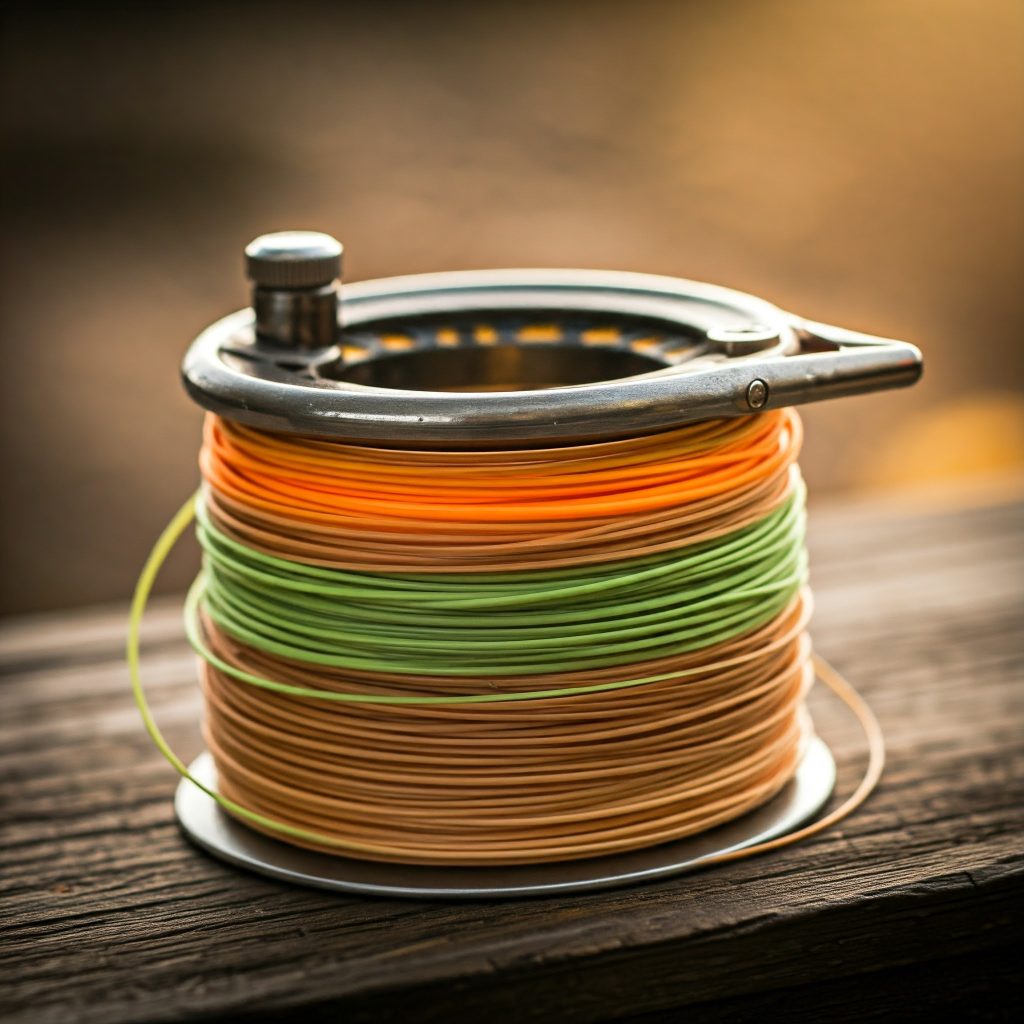
Types of Fly Lines
There are several types of fly lines, each designed for specific fishing scenarios. Beginners should familiarize themselves with the following types:
- Weight Forward (WF) Line: This type of line features a heavier front section that allows for easier casting, making it an excellent choice for beginners. WF lines are versatile and can be used for various techniques and conditions.
- Double Taper (DT) Line: DT lines have a uniform thickness throughout, with a tapered front and back. They are great for delicate presentations and roll casting but may require more skill to use effectively. Beginners may find WF lines more user-friendly.
- Sinking Lines: Sinking lines are designed to sink below the water’s surface, allowing anglers to target fish at various depths. These lines are beneficial for fishing in deeper waters or when targeting species that feed near the bottom.
- Floating Lines: Floating lines remain on the water’s surface, making them ideal for dry fly fishing and surface presentations. Beginners often start with floating lines to practice their casting techniques.
Weight and Taper
Fly lines are rated based on their weight, which should match the weight of your fly rod and reel. For example, if you have a 5-weight rod, you should use a 5-weight line.
- Line Taper: The taper of the line affects how it casts and presents flies. A line with a long taper is suitable for delicate presentations, while a short taper is better for casting larger flies over long distances.
Line Maintenance
Proper maintenance of your fly line is essential for optimal performance. Here are some tips for beginners to keep in mind:
- Cleaning: Regularly clean your fly line to remove dirt, debris, and oils. Use a line cleaning solution and a soft cloth to wipe down the line after each use. This will extend its lifespan and improve casting performance.
- Storage: When storing your fly line, avoid coiling it tightly. Instead, store it on a spool or lay it flat to prevent kinking or damaging the line.
Fly Patterns and Flies: The Bait of Fly Fishing
Selecting the right flies is a crucial aspect of successful fly fishing. Understanding different fly patterns and how they imitate natural prey will help beginners become more effective anglers.
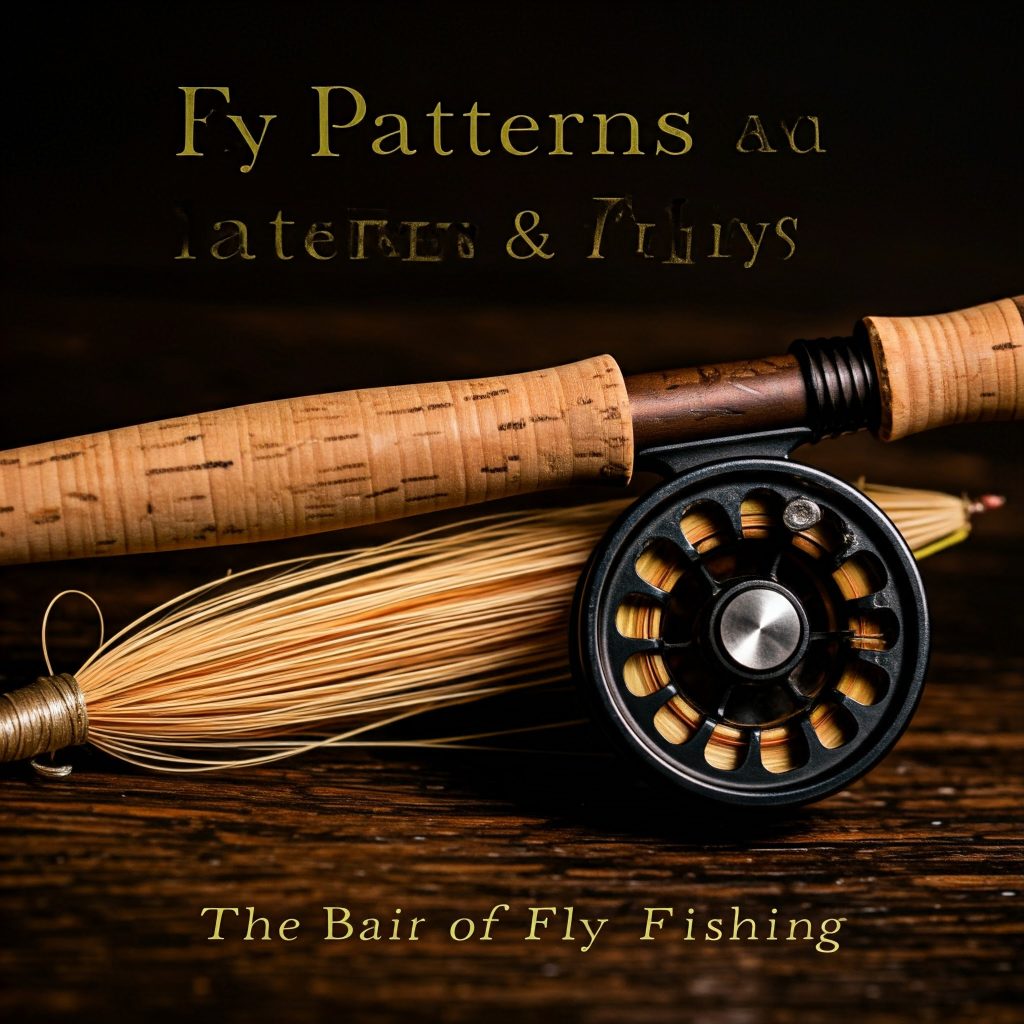
Types of Flies
Flies can be categorized into two main types: dry flies and wet flies. Each type serves a different purpose and is designed to imitate various aquatic insects and organisms.
- Dry Flies: Dry flies float on the water’s surface and imitate insects like mayflies, caddisflies, and grasshoppers. They are often used in calm waters and are popular for targeting rising fish. Beginners should familiarize themselves with common dry fly patterns, such as Adams, Elk Hair Caddis, and Royal Wulff.
- Wet Flies: Wet flies are designed to sink below the water’s surface and imitate nymphs, larvae, or drowned insects. They are effective for targeting fish that feed beneath the surface. Popular wet fly patterns include Woolly Bugger, Hare’s Ear Nymph, and Pheasant Tail.
Matching the Hatch
Understanding the concept of “matching the hatch” is vital for fly selection. This refers to using flies that closely resemble the natural insects present in the fishing environment. Observing the water and identifying the insects can significantly increase your chances of success.
- Observation: Spend time observing the water’s surface for rising fish and insects. Take note of the size, shape, and color of the insects to select the most appropriate fly.
- Seasonal Changes: Different insects hatch at various times throughout the year. Familiarizing yourself with local insect hatches and seasonal patterns will help you choose the right flies for your fishing outings.
Fly Construction
When starting, beginners can purchase pre-tied flies, but learning to tie your own flies can enhance your fishing experience. Fly tying allows for customization and creativity, enabling you to create flies that match specific conditions or preferences.
- Basic Materials: Common materials for fly tying include hooks, threads, feathers, fur, and synthetic materials. Understanding the different materials and their properties will help you create effective flies.
- Tying Techniques: Beginners can learn basic fly tying techniques through online tutorials, books, or local fly tying classes. Mastering a few essential patterns can enhance your fishing success and provide a rewarding hobby.
Additional Accessories: Completing Your Fly Fishing Setup
In addition to the primary gear, several accessories can enhance your fly fishing experience. While they may not be strictly necessary, these items will improve comfort, convenience, and overall success on the water.
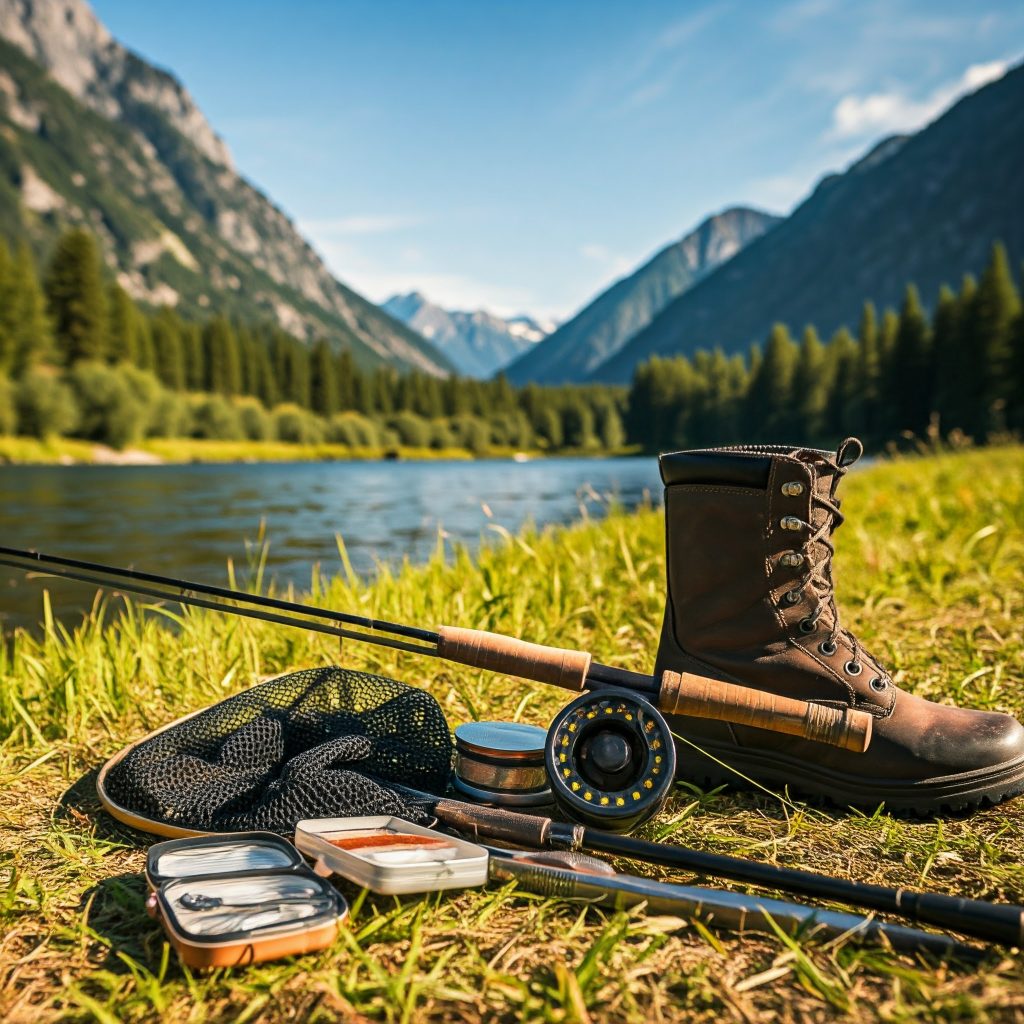
Fishing Vest or Pack
A fishing vest or pack allows you to carry essential gear and accessories while keeping your hands free.
- Vests: Fishing vests feature multiple pockets for storing flies, tools, and other essentials. They are designed for comfort and ease of access, allowing you to quickly grab what you need while on the water.
- Backpacks: For longer excursions or when hiking to remote fishing locations, a fishing backpack provides ample storage for gear, food, and water. Look for backpacks with specialized compartments for rods and reels.
Landing Net
A landing net is essential for safely landing fish without causing harm.
- Types of Nets: There are various types of landing nets available, including rubberized nets and traditional mesh nets. Rubberized nets are preferred for catch-and-release fishing, as they are gentler on fish and reduce the risk of removing their protective slime layer.
- Size and Shape: Choose a landing net that suits the species you are targeting. Smaller nets are suitable for panfish, while larger nets are necessary for bigger species like trout or bass.
Tippet and Leaders
Tippet and leaders are vital components that connect your fly line to the fly.
- Leaders: A leader is a length of monofilament or fluorocarbon line that connects the fly line to the tippet. Leaders typically range from 7.5 to 12 feet in length and vary in strength.
- Tippet: Tippet is the final connection between the leader and the fly. It is typically thinner than the leader line and comes in various sizes (measured in pound test). Beginners should choose tippet that matches the size of the flies they plan to use.
Tools and Accessories
Several other tools and accessories can enhance your fly fishing experience:
- Nippers: Nippers are essential for cutting line and tippet. A good pair of nippers can make it easier to manage your gear on the water.
- Forceps: Forceps are handy for removing hooks from fish and can also be used to pinch down barbs or hold flies while tying.
- Fly Box: A fly box keeps your flies organized and protected. Look for a fly box with adjustable compartments to accommodate various fly sizes and styles.
Conclusion
Fly fishing offers a rewarding experience for beginners eager to connect with nature and enjoy the thrill of fishing. By understanding the essential gear required, including fly rods, reels, lines, flies, and accessories, beginners can set themselves up for success on the water. While the initial investment may seem daunting, choosing quality gear will enhance the fishing experience and foster a deeper appreciation for this timeless sport. As beginners gain confidence and experience, they can expand their gear and techniques, making fly fishing a lifelong pursuit filled with excitement and adventure.







